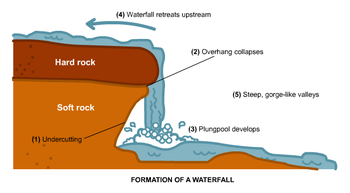Difference between revisions of "AY Honors/Waterfalls/Answer Key"
| (One intermediate revision by the same user not shown) | |||
| Line 29: | Line 29: | ||
; Tiered : Water drops in a series of distinct steps or falls. | ; Tiered : Water drops in a series of distinct steps or falls. | ||
; Multi step : A series of waterfalls one after another of roughly the same size each with its own sunken plunge pool. | ; Multi step : A series of waterfalls one after another of roughly the same size each with its own sunken plunge pool. | ||
| − | {{-}} | + | {{-}} |
| − | |||
==Examples of large waterfalls== | ==Examples of large waterfalls== | ||
{{main|List of waterfalls}} | {{main|List of waterfalls}} | ||
| Line 46: | Line 45: | ||
* [[Jog Falls]], India's highest and second highest in [[Asia]], located in [[Karnataka]] state, [[India]] | * [[Jog Falls]], India's highest and second highest in [[Asia]], located in [[Karnataka]] state, [[India]] | ||
* [[Jurong Falls]] in [[Singapore]] is said to be the tallest man-made waterfall in the world | * [[Jurong Falls]] in [[Singapore]] is said to be the tallest man-made waterfall in the world | ||
| + | |||
| + | I love waterfalls | ||
==External links== | ==External links== | ||
Revision as of 21:48, 15 November 2006
- Waterfalls redirects here. For the Paul McCartney single, see Waterfalls by Paul McCartney.
A waterfall is usually a geological formation resulting from water, often in the form of a stream, flowing over an erosion-resistant rock formation that forms a sudden break in elevation. Waterfalls may also be artificial, and they are sometimes created as garden and landscape ornament.
Some waterfalls form in mountain environments where erosion is rapid and stream courses may be subject to sudden and catastrophic change. In such cases, the waterfall may not be the end product of many years of water action over a region, but rather the result of relatively sudden geological processes such as landslides, faults or volcanic action.
Formation
Typically, a stream flow across an area of formations strata will form shelves across the streamway, elevated above the further stream bed when the less erosion-resistant rock around it disappears. Over a period of years, the edges of this shelf will gradually break away and the waterfall will steadily retreat upstream, creating a gorge of recession. Often, the rock stratum just below the more resistant shelf will be of a softer type, meaning undercutting, due to splashback, will occur here to form a shallow cave-like formation known as a rock shelter (also known as a rock house) under and behind the waterfall. Eventually, the outcropping, more resistant cap rock will collapse under pressure to add blocks of rock to the base of the waterfall. These blocks of rock are then broken down into smaller boulders by attrition as they collide with each other, and they also erode the base of the waterfall by abrasion, creating a deep plunge pool.
Waterfalls can also form due to glaciation, whereby a stream or river flowing into a glacier continues to flow into a valley after the glacier has receded or melted. The large waterfalls in Yosemite Valley are examples of this phenomenon.
Streams become wider and more shallow just above waterfalls due to flowing over the rock shelf, and there is usually a deep pool just below the waterfall due to the kinetic energy of the water hitting the bottom.

Types of waterfalls
- Block
- Water descends from a relatively wide stream or river.
- Cascade
- Water descends a series of rock steps.
- Cataract
- A large waterfall. See Cataracts of the Nile for a well-known sequence of six.
- Fan
- Water spreads horizontally as it descends while remaining in contact with bedrock.
- Horsetail
- Descending water maintains some contact with bedrock.
- Plunge
- Water descends vertically, losing contact with the bedrock surface.
- Punchbowl
- Water descends in a constricted form, then spreads out in a wider pool.
- Segmented
- Distinctly separate flows of water form as it descends.
- Tiered
- Water drops in a series of distinct steps or falls.
- Multi step
- A series of waterfalls one after another of roughly the same size each with its own sunken plunge pool.
Examples of large waterfalls
- Angel Falls, the world's highest at 979 m (3212 ft), in Venezuela
- Tugela Falls, the world's second highest at 947 m (3110 ft), in KwaZulu-Natal province, Republic of South Africa.
- Ramnefjellsfossen, the world's third highest at 808m (2685 ft), at Stryn, Nesdalen, Norway.
- Victoria Falls, the world's widest, on the Zambezi River, on the border between Zambia and Zimbabwe
- Boyoma Falls, with the world's highest volume, 17,000 m³/s (600,000 ft³/s), on the Congo River, Democratic Republic of the Congo
- Gocta, the fifth highest in the world at 771 m (2533 ft), located in the province Chachapoyas, Peru
- Yosemite Falls, arguably the tallest in North America, located in Yosemite National Park, United States
- Niagara Falls, most voluminous in North America, on the border between the United States and Canada
- Rhine Falls, Europe's largest, located in Switzerland
- Iguazu Falls, a tall and extremely wide fall located in South America on the Argentina/Brazil border
- Jog Falls, India's highest and second highest in Asia, located in Karnataka state, India
- Jurong Falls in Singapore is said to be the tallest man-made waterfall in the world
I love waterfalls
External links
id:Air terjun su:Curug ca:Cascada cs:Vodopád da:Vandfald de:Wasserfall et:Juga es:Cascada eo:Akvofalo eu:Ur-jauzi fr:Chute d'eau gd:Eas gl:Fervenza gu:ધોધ is:Foss it:Cascata he:מפל מים la:Cataracta lt:Krioklys nl:Waterval ja:滝 no:Foss nn:Foss pl:Wodospad pt:Cachoeira ru:Водопад simple:Waterfall sl:Slap fi:Vesiputous sv:Vattenfall vi:Thác tr:Şelâle uk:Водоспад zh:瀑布


